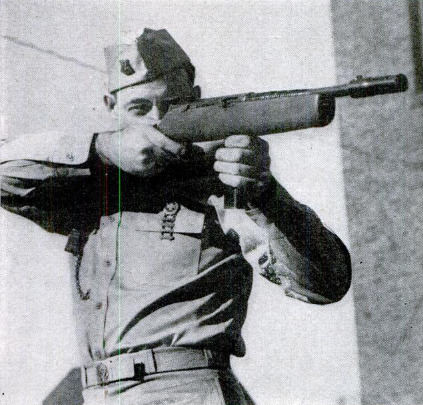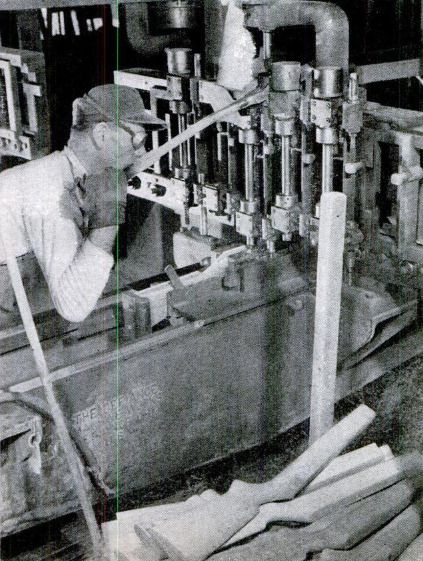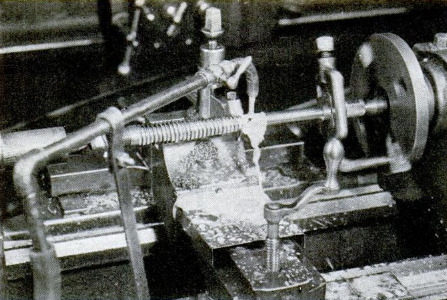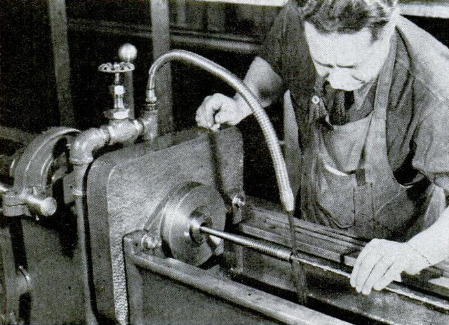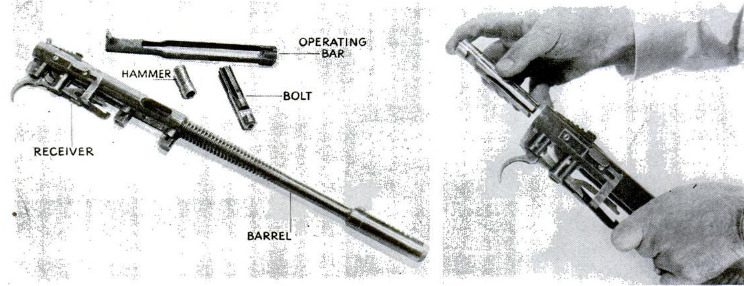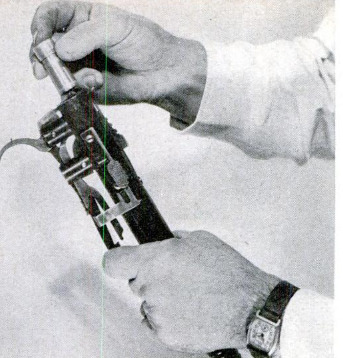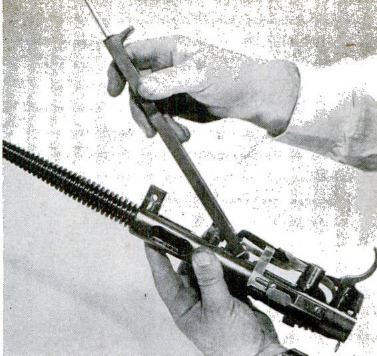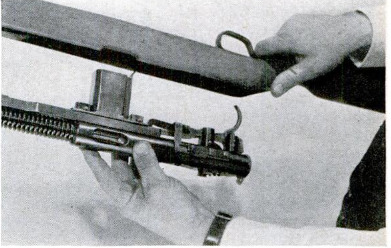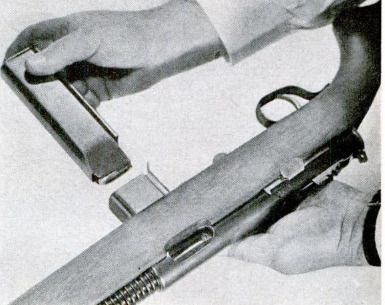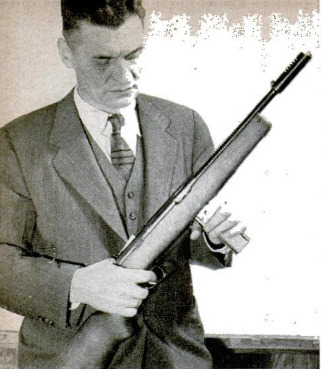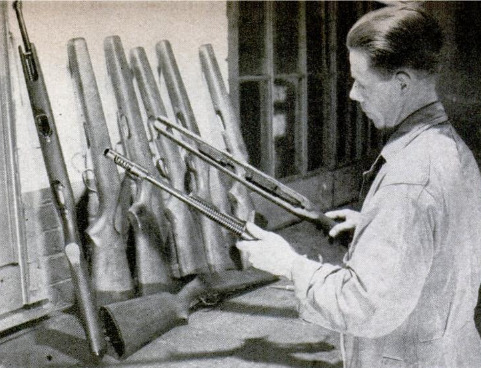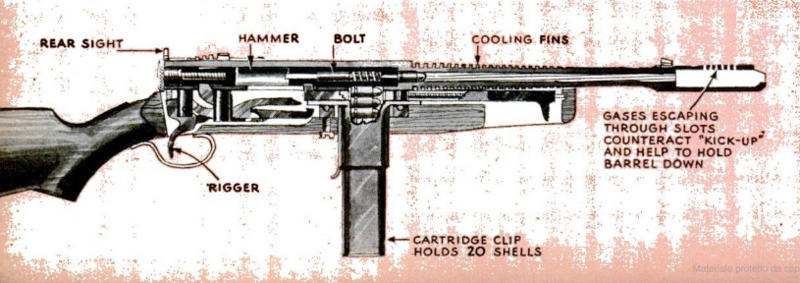-
Title (Dublin Core)
-
Latest submachine gun is designed for mass production
-
Article Title and/or Image Caption (Dublin Core)
-
Title: Latest submachine gun is designed for mass production
-
extracted text (Extract Text)
-
A NEW submachine gun which
shoots .45 caliber automatic
pistol bullets at the rate of
500 a minute is now being turned
out by the Harrington and Rich-
ardson Arms Company, of Worces-
ter, Mass. at the rate of 1,000 guns
a day.
Although in its present form the
gun weighs only 614 pounds as com-
pared with the 9%-pound Thomp-
son submachine gun and the U.S.
Army's new 91-pound Garand ri-
fle, the inventor, Eugene G. Reis-
ing, is confident that eventually he
will cut its weight down close to
the five pounds which the War De-
partment considers ideal for para-
chute troops, air infantry, motor-
cycle riders, and the close-up work
of mechanized units. He is also
adapting it to fire the .30 caliber
carbine cartridge.
Just as important as its light
weight, however, is its simplicity.
The Reising has only three moving
parts—the hammer, bolt, and ac-
tion bar—compared with eight in
the widely used Thompson (“Tom-
my") gun. According to the Worces-
ter experts, it is easier to make
a complete Reising gun than it is to
turn out any one of the three most
complex parts of a comparable
weapon. Because of the simplicity
of its construction the tolerances of
error allowable in the Reising are
much wider, making it entirely
practical to manufacture the gun
in any machine shop without spe-
cial tools. Actually a large part of
the machine tools being used at the
present time to produce the 1,000
Reisings a day are fifty years old.
Although special tools are not
required, several are being used to
speed production. Notably, the
Reising barrels are being rified by
the broaching method. Heretofore
gunmakers have rifled barrels by a
process requiring the tool to make
a number of trips through the bar-
rel, cutting the rifling grooves
slightly deeper each time, By
broaching, the 11-inch barrel
of the Reising is rifled in one
trip through, taking only one
minute instead of the old
method's 15 minutes. With
the installation of an auto-
matic lathe, only 12 minutes
will be required to finish a
barrel, from the solid steel
bar to the final bluing.
Simple as it is, the Reising
is capable of grouping a high
percentage of its shots inside
a ten-inch circle at 200 yards,
and that, remember, is with
standard .45 automatic pistol
ammunition. One reason for
this accuracy is the compen-
sator, which is screwed onto
the muzzle like a silencer.
Slots on its top side permit
the gases leaving the muzzle
to expand upward, while a
small shelflike projection on
the under side of the com-
pensator takes a downward
push from the gases, and
these two effects combine to
keep the muzzle down and on
the target, eliminating al-
most all the “jump” of the
muzzle. The recoil, or kick,
also is very slight.
The Reising can be fired
either semiautomatically, one
shot at a time, or automati-
cally at full speed by holding
down the trigger. No hand-
held weapon, of course, can
be as accurate when fired au-
tomatically as when fired one
shot at a time and sighted for
each shot. Also, the short-
ness of the barrel prevents
accuracy equal to a rifle’s. Like most
submachine guns, the Reising has an
effective range of 300 yards.
The .45 caliber bullet leaves the muz-
zle at a velocity of 900 feet a second.
Velocity and the bullet size both figure
in the hitting force and penetrating
power. Rifle and carbine bullets tend to
drill a clean hole through a man, and he
may continue to advance for some yards
after being struck in certain parts of
his body. The .45 caliber slug, on the
other hand, will almost always knock a
man down or spin him around—a val-
uable asset in close-up fighting where
it is necessary to disable the other fel-
low before he can get you.
The Reising gun takes a 20-shot clip
magazine, and a 50-round drum can be
adapted to it if wanted. Thanks to its
simplicity, it can be sold for around $85,
or, in military mass production, for $45
to $50, Which is a lot less than the $225
price of a comparable submachine gun
now in wide use.
Like the Thompson, the Reising gun
is of the delayed blow-back reloading
type. A pressure of 42 pounds is re-
quired to force the bolt to cam itself out
of a locked position. A shoulder half
encircles the upper part of the bolt; this
fits snugly up against a mating recess
in the upper inside part of the receiver.
These locking parts are milled at an
angle to provide transfer of the reaction
from one plane to another. The re-
action pushes the fired cartridge shell
back until it engages the ejector and is
flipped out. ‘The same movement cocks
the hammer. A retracting spring pulls the
bolt forward; on its way the bolt picks up a
loaded cartridge from the clip and feeds it
into the chamber and then fires it. The
whole takes (at the rate of 500 a minute)
about 3/25 of a second.
Despite its short barrel, the gun has a
sighting radius of 1814 inches. The barrel,
of nickel chrome steel, has cooling fins sim-
ilar to those on the Thompson gun. After
100 rounds rapid fire it is not sizzling hot,
and one of the first Reising guns made has
been fired more than 9,500 times without
any signs of charring the stock and also
without overhauling.
The gun can he taken apart without even
using a cartridge as a tool. Unlike other
submachine guns, it does not have to be lu-
bricated continuously, and Army tests at
the Aberdeen, Md., proving grounds showed
that it could even be fired dry of oil. In these
tests, 3,470 rounds were fired with but two
failures, one due to a defective cartridge
and the other ascribed to incomplete lock-
ing of the breech.
The inventor, Reising (pronounced “Rise-
ing") holds more than 60 patents on pistols
and guns. Many experts consider his .22
caliber automatic pistol the best ever made
in this country. Of Swedish stock that
came to Delaware in 1635, Reising was born
at Port Jervis, N. Y., son of a railroad en-
gineer who died when Eugene was an in-
fant. The boy attended Lehigh University
three years, then punched cattle in Texas
and Mexico a few years. On returning
north, he went to work for Colt, testing and
selling arms. He helped John Browning de-
velop the famed Colt .45 automatic pistol.
Just before the first World War, Reising
designed a simplified machine gun. Later
he designed repeating and automatic rifles
for Mossberg & Sons, Marlin, Savage, and
Stevens. The keynote of nearly all his 30
designs is ease of manufacture.
Besides the U.S. Army, the war depart-
ments of Great Britain, Greece, the Nether-
lands East Indies, Iraq, and several South
American countries have expressed keen
interest in this apparent answer to an
ordnance officer's prayer: a simple, very
light, easily made arm, sturdy, dependable
—that can be turned out in a shop without
costly equipment.—WALTER HOLBROOK.
-
Language (Dublin Core)
-
Eng
-
Date Issued (Dublin Core)
-
1941-04
-
pages (Bibliographic Ontology)
-
73-76
-
Rights (Dublin Core)
-
Public domain
-
Archived by (Dublin Core)
-
Sami Akbiyik
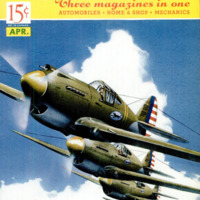 Popular Science Monthly, v. 138, n. 4, 1941
Popular Science Monthly, v. 138, n. 4, 1941

